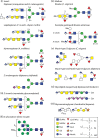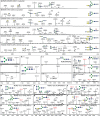Anionic and zwitterionic moieties as widespread glycan modifications in non-vertebrates
- PMID: 31278613
- PMCID: PMC6994554
- DOI: 10.1007/s10719-019-09874-2
Anionic and zwitterionic moieties as widespread glycan modifications in non-vertebrates
Abstract
Glycan structures in non-vertebrates are highly variable; it can be assumed that this is a product of evolution and speciation, not that it is just a random event. However, in animals and protists, there is a relatively limited repertoire of around ten monosaccharide building blocks, most of which are neutral in terms of charge. While two monosaccharide types in eukaryotes (hexuronic and sialic acids) are anionic, there are a number of organic or inorganic modifications of glycans such as sulphate, pyruvate, phosphate, phosphorylcholine, phosphoethanolamine and aminoethylphosphonate that also confer a 'charged' nature (either anionic or zwitterionic) to glycoconjugate structures. These alter the physicochemical properties of the glycans to which they are attached, change their ionisation when analysing them by mass spectrometry and result in different interactions with protein receptors. Here, we focus on N-glycans carrying anionic and zwitterionic modifications in protists and invertebrates, but make some reference to O-glycans, glycolipids and glycosaminoglycans which also contain such moieties. The conclusion is that 'charged' glycoconjugates are a widespread, but easily overlooked, feature of 'lower' organisms.
Keywords: Glucuronic acid; Glycans; Glycomics; Insect; Mollusc; Nematode; Phosphoethanolamine; Phosphorylcholine; Sulphate.
Conflict of interest statement
The authors declare that they have no conflicts of interest.
Figures



Similar articles
-
Analysis of zwitterionic and anionic N-linked glycans from invertebrates and protists by mass spectrometry.Glycoconj J. 2016 Jun;33(3):273-83. doi: 10.1007/s10719-016-9650-x. Epub 2016 Feb 22. Glycoconj J. 2016. PMID: 26899268 Free PMC article. Review.
-
Comparisons of N-glycans across invertebrate phyla.Parasitology. 2019 Dec;146(14):1733-1742. doi: 10.1017/S0031182019000398. Epub 2019 May 3. Parasitology. 2019. PMID: 31046847 Free PMC article. Review.
-
Introduction to the Complexity of Cell Surface and Tissue Matrix Glycoconjugates.Adv Neurobiol. 2023;29:1-39. doi: 10.1007/978-3-031-12390-0_1. Adv Neurobiol. 2023. PMID: 36255670
-
Structures and functions of invertebrate glycosylation.Open Biol. 2019 Jan 31;9(1):180232. doi: 10.1098/rsob.180232. Open Biol. 2019. PMID: 30958118 Free PMC article. Review.
-
Negative-mode mass spectrometry in the analysis of invertebrate, fungal, and protist N-glycans.Mass Spectrom Rev. 2022 Nov;41(6):945-963. doi: 10.1002/mas.21693. Epub 2021 May 6. Mass Spectrom Rev. 2022. PMID: 33955035 Free PMC article. Review.
Cited by
-
The biosynthesis and role of phosphorylcholine in pathogenic and nonpathogenic bacteria.Trends Microbiol. 2023 Jul;31(7):692-706. doi: 10.1016/j.tim.2023.01.006. Epub 2023 Feb 28. Trends Microbiol. 2023. PMID: 36863982 Free PMC article. Review.
-
A general approach to explore prokaryotic protein glycosylation reveals the unique surface layer modulation of an anammox bacterium.ISME J. 2022 Feb;16(2):346-357. doi: 10.1038/s41396-021-01073-y. Epub 2021 Aug 2. ISME J. 2022. PMID: 34341504 Free PMC article.
-
New insights into the N-glycomes of Dictyostelium species.BBA Adv. 2025 Jan 16;7:100142. doi: 10.1016/j.bbadva.2025.100142. eCollection 2025. BBA Adv. 2025. PMID: 39911813 Free PMC article.
-
Sulfated and sialylated N-glycans in the echinoderm Holothuria atra reflect its marine habitat and phylogeny.J Biol Chem. 2020 Mar 6;295(10):3159-3172. doi: 10.1074/jbc.RA119.011701. Epub 2020 Jan 22. J Biol Chem. 2020. PMID: 31969392 Free PMC article.
-
The role of glycoconjugates as receptors for insecticidal proteins.FEMS Microbiol Rev. 2023 Jul 5;47(4):fuad026. doi: 10.1093/femsre/fuad026. FEMS Microbiol Rev. 2023. PMID: 37279443 Free PMC article. Review.
References
Publication types
MeSH terms
Substances
Grants and funding
LinkOut - more resources
Full Text Sources

